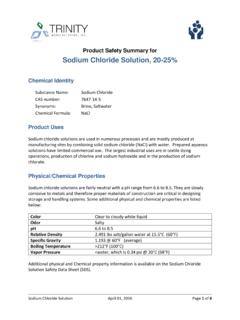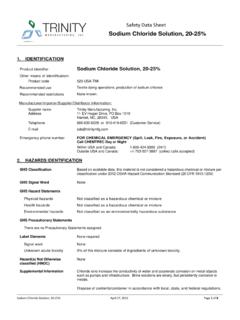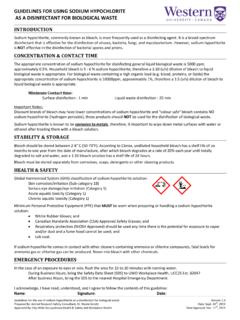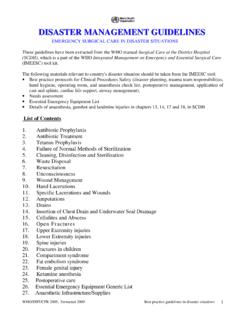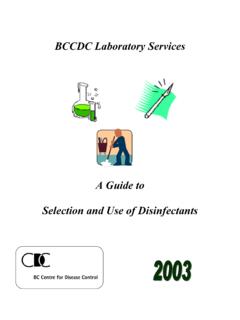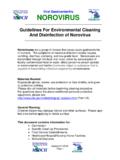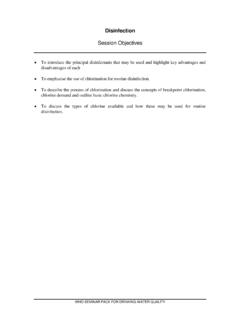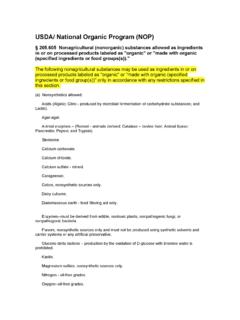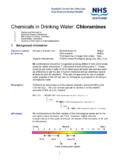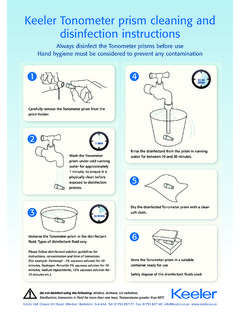Transcription of Product Safety Summary for Sodium Hypochlorite …
1 Sodium Hypochlorite Solution April 01, 2016 Page 1 of 5 Product Safety Summary for Sodium Hypochlorite Solution, 10-16% Chemical Identity Name: Sodium Hypochlorite CAS number: 7681-52-9 Synonyms: Bleach, Hypo Chemical Formula: NaOCl Product Uses Trinity Manufacturing, Inc. produces Tri-Lite brand Sodium Hypochlorite in 10-16% by weight solutions , which are marketed by Oltrin solutions , LLC. Sodium Hypochlorite has many beneficial applications, including use as a biocide, bleaching agent and disinfectant. The primary use is in water treatment, which includes municipal, industrial, and swimming pool treatment applications for sanitation and disinfecting purposes. Physical/Chemical Properties Sodium Hypochlorite is found only in solution with water. Solid Sodium Hypochlorite is unstable at room temperature and therefore generally does not exist. Sodium Hypochlorite solutions are powerful oxidants and are pale yellow in appearance with a chlorine-like odor.
2 Some additional physical and chemical properties are listed below: Color Pale yellow straw colored Odor Chlorine-like pH 13 Relative Density @ C (60 F) ( % by weight available chlorine) Freezing Point C (-17 F) Boiling Temperature 111 C ( F) Vapor Pressure 12mmHg @ 20 C (68 F) for by weight solution Solubility in Water 100% Additional physical and chemical property information is available on the Sodium Hypochlorite Solution Safety Data Sheet (SDS). Sodium Hypochlorite Solution April 01, 2016 Page 2 of 5 Human Health Information Sodium Hypochlorite solutions are strongly alkaline, meaning they have high pH, often greater than 13. Due to this, Sodium Hypochlorite is a severe eye, skin, and respiratory tract irritant, and it can burn tissue with which it comes in contact. Eye contact is a serious hazard, as it can cause severe irritation and possible blindness.
3 Inhaling aerosols or fumes of Sodium Hypochlorite may result in irritation of the nose and throat. Ingesting Sodium Hypochlorite may cause pain and burns of the esophagus and gastrointestinal tract. Liberation of dangerous amounts of toxic gas may occur if Sodium Hypochlorite is mixed with acid or ammonia. Additional data on acute and chronic health effects can be found on the Product Safety Data Sheet (SDS). Environmental Information Persistence & Degradability Contains inorganic compounds which are not biodegradable. Degrades slowly to Sodium chloride, Sodium chlorate and oxygen. Bioaccumulation Not expected to bioaccumulate. Aquatic Life Toxic to aquatic life with long lasting effects. For more data, see Product Safety Data Sheet (SDS). Potential Exposure The most likely ways exposures can occur are: Manufacturing or Industrial Workplace Exposure: Exposure could occur in the manufacturing facility or in industrial facilities that use Sodium Hypochlorite .
4 Typical exposures are to the skin or eyes during maintenance, sampling, or testing. Where possible, control exposure hazards through engineered and administrative controls. Otherwise, follow good industrial hygiene practices and utilize personal protective equipment, as outlined in the Chlorine Institute s Pamphlet 65 to minimize the risk of exposure. (See Sources for Additional Information below.) Consumer Exposure: Trinity Manufacturing does not sell Sodium Hypochlorite in retail stores, though it may be an ingredient in some consumer products. Exposure to these products is deemed safe if used in accordance with the label instructions. Environmental Exposure: Release to the environment may occur during the manufacture, storage, or transport of Sodium Hypochlorite . If a spill occurs, emergency personnel should wear protective equipment to minimize exposures. Should the Product require neutralization, special care should be given as off-gassing of chlorine vapors may occur.
5 Before disposing of any significant volumes of aqueous solutions of Sodium Hypochlorite to Sodium Hypochlorite Solution April 01, 2016 Page 3 of 5 any sanitary discharge system or receiving body of water, contact your local environmental regulating agency and/or plant management first. Proper neutralization is critical because Sodium Hypochlorite can kill beneficial microorganisms thereby disrupting sewage or other treatment plant operations by causing failure of the biological or chemical treatment processes. More information on prevention and mitigation of potential exposures is available in the Sodium Hypochlorite Safety Data Sheet. Risk Management Sodium Hypochlorite is non-flammable, non-explosive, and non-toxic. It is, however, an alkaline material and poses hazards to the skin and eyes. Sodium Hypochlorite can react with certain materials of construction. Prior to using Sodium Hypochlorite , carefully read and understand the Safety Data Sheet.
6 The following are some risk management measures that are effective against these hazards: Provide eyewash fountains and Safety showers in areas where Sodium Hypochlorite is used or handled. Flush areas of the body that have come in contact with Sodium Hypochlorite with large amounts of water, and then seek medical attention. DO NOT use any kind of neutralizing solution, particularly in the eyes, without direction from a physician. To prevent eye contact during use or handling, protective eye wear (such as splash goggles, a full face shield, or Safety glasses with side shields) must be worn. Work areas where Sodium Hypochlorite is used should be well-ventilated to maintain concentrations below exposure limits. If exposures exceed accepted limits or if respiratory discomfort is experienced, use a NIOSH approved air purifying respirator with high efficiency particulate filters.
7 Wear chemical resistant clothing, appropriate for the strength of Hypochlorite , to prevent contact with the body. Wear Hypochlorite -resistant gloves appropriate to protect the hands while handling this Product . Glove sleeves should be long enough to fit well above the wrist while sleeves should be positioned securely over the glove wrists. When wearing Sodium Hypochlorite -resistant boots, wear the bottoms of trouser legs outside the boots. DO NOT tuck in. Proper labeling, handling and storage of Sodium Hypochlorite will reduce the likelihood of accidental ingestion. Equipment used for Sodium Hypochlorite storage or processing should be constructed of the proper materials. For more detailed information regarding materials of construction, refer to the Chlorine Institute, Pamphlet 96. (See Sources for Additional Information below.) Sodium Hypochlorite Solution April 01, 2016 Page 4 of 5 Personnel involved with Sodium Hypochlorite handling operations should be properly trained.
8 Product Stewardship Trinity Manufacturing has prepared a Bleach Handbook that outlines various topics related to Sodium Hypochlorite . This book is intended to be a quick reference guide for common questions asked by customers. More in depth information may be obtained by contacting your Trinity Manufacturing representative. Regulatory Information The following is a Summary of regulations and guidelines that pertain to Sodium Hypochlorite (additional regulations and guidelines may apply): Under the Comprehensive Environmental Resource and Conservation Liability Act (CERCLA) any release of 100 pounds or more of Sodium Hypochlorite to the environment within a 24-hour period, not specifically allowed by a permit, must be reported to the National Response Center (NRC). This release would be the equivalent of 800 pounds of 15% trade Sodium Hypochlorite . Sodium Hypochlorite is regulated by the Department of Transportation (DOT) as a corrosive hazardous material.
9 Sodium Hypochlorite is subject to annual Community Right-to-Know Reporting Requirements in 40 CFR Section 370, Subpart B, commonly known as Tier II Reporting In the United States, Sodium Hypochlorite solutions that are labeled and used for disinfection and/or sanitization are pesticides regulated by the Environmental Protection Agency under the Federal Insecticide, Fungicide and Rodenticide Act (FIFRA). All states, and some local governments, have laws requiring the registration of pesticides. The American Industrial Hygiene Association (AIHA) recommends a Workplace Environmental Exposure Level (WEEL) Guide for Sodium Hypochlorite solutions at 2 mg/m3, 15-minute time-weighted average exposure. Sources for Additional Information Chlorine Institute, Pamphlet 96, April 2006 Personal Protective Equipment for Chlor-Alkali Chemicals Chlorine Institute, Pamphlet 65, November 2001 Sodium Hypochlorite Manual Grant, W.
10 Morton (1986). Toxicology of the Eye, Clarence C. Thomas, Pub. Trinity Manufacturing Safety Data Sheet at our web site: Sodium Hypochlorite Solution April 01, 2016 Page 5 of 5 Contact Information For additional information, call Trinity Customer Service at (800) 632-6228 or (910) 419-6551. Trinity Manufacturing, Inc. PO Box 1519, 11 Hogan Drive Hamlet, NC 28345 This Product Safety Summary is intended to provide a general overview of the chemical substance. The information on the Summary is basic information and is not intended to provide emergency response information, medical information, or treatment information. For in-depth Safety and health information, refer to the Product s Safety Data Sheet (SDS), the Product s label, and other safe use and handling literature for the chemical substance.
